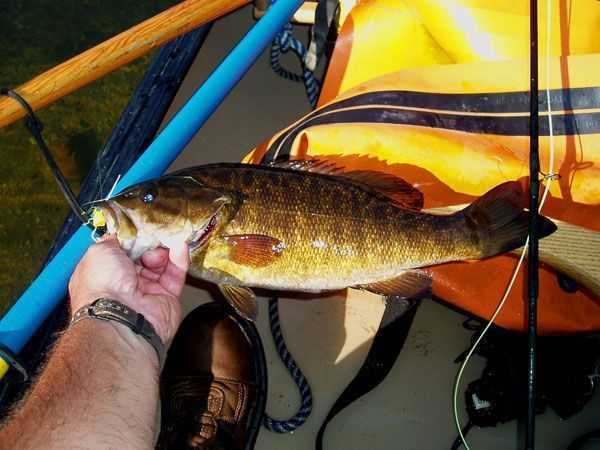I n just a few weeks, fishing for mountain trout in western North Carolina will start to wind down for many anglers. But just as the interest in trout fishing slows, smallmouth bass activity picks up. For many anglers, summer is prime smallmouth season, especially for fly fishermen. Their aggressive, hard-fighting tactics make them quite popular. And, for many anglers, there are few things more satisfying than an aggressive smallie attacking a big floating fly on the surface of the river.
There are plenty of places to fish for smallies. Top choices are rivers like the Yadkin, New, Toe, French Broad, Nolichucky etc. Also, there are also lots of smaller streams that have a good population of smallies. The state’s biologists have done a lot of work to survey and identify many of these smaller bodies of water.
Many of our rivers and small waterways are easily waded. In the summer, most are comfortable enough for wet wading in shorts, and wading boots for traction and foot protection. In some cases, a little research and map study is necessary to identify parts of our rivers that are accessible and suitable for the wading angler. Studying a DeLorme Atlas, and keyboarding with the state’s new interactive map at ncwildlife.org, will identify some options. Combine that with a little reconnaissance from the road, and you can identify some spots for fishing afoot.
For many folks, smallmouth fishing allows them to combine two of their favorite activities…fishing and floating. A personal watercraft like an inflatable pontoon boat, kayak or canoe will open up new territory to the angler and provide access to spots that wading anglers cannot access. It also allows them to quickly paddle or row through unproductive stretches of stream or river.
On many of our waterways, canoe and tube rental companies are willing to shuttle fishermen who have their own boats. This is a convenient option and eliminates the need for multiple vehicles and time lost to shuttling them between put-in and take-out points. There may also be private individuals willing to drive shuttle vehicles for a small fee.
One of the best ways to fish and explore for smallies is to launch a canoe or kayak and paddle upstream. This can be surprisingly easy on many slow moving stretches of waterway. In some cases, hug the bank where the current is slowest…or ferry back and forth from one large eddy to another. When you get to faster current or a small drop or ledge, hop out of the boat and wade and tow the craft upstream. An unloaded canoe or kayak offers hardly any resistance. You can tie the tow rope to your waist and wade and fish your way through faster water.
Wading and fishing upstream will allow you to thoroughly prospect promising water. When it’s time to turn around, climb back aboard your craft and work your way back downstream. It’s a productive system that’s feasible on many rivers and streams. It also allows you to fish a specified amount of time, or fish at your own leisurely pace.
Almost any lightweight tackle and a selection bass lures work well for smallies. The fly fisherman will probably be best served with a 6-8 wt. fly rod and a selection of top-water bugs like poppers and sliders, and sinking flies like minnow and crayfish imitations. Some of your larger smallies can put up quite a fight, and the heavier outfits are nice. Most importantly, however, 7 or 8 weight outfits makes fly casting easier with bigger, more wind-resistant flies. Often bigger flies will eliminate the annoyance of smaller sunfish and redeyes…and result in bigger bass.
Whichever route you choose can prove successful for smallie fishing during the summer. Even though it may be hot and dry, don’t let summer temperatures and low water keep you off the water. Those can be some of the best times on the river as well as a good way to beat the heat.
